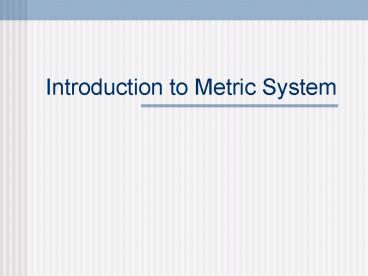Introduction to Metric System - PowerPoint PPT Presentation
Title: Introduction to Metric System
1
Introduction to Metric System
2
The Metric Scale System
- K H D S D C M
- Kilo Hecto Deca Deci Centi
Milli - (h) (da) (d)
(c) (m) - grams
- meters
- liters
- BIG SMALL
3
EASY WAY TO REMEMBER
- King Henry Died Sunday Drinking Chocolate Milk
4
MASS
- The amount of matter that is packed into an
object. - Use grams to measure mass
5
GRAMS
- The Symbol g
- Measures non-liquids
- Commonly used in cooking food labeling
6
What do we use to measure Grams?
- We will use a Triple Beam Balance
7
How to use a Triple Beam Balance
- 1. Zero the balance
- 2. Slide all of the riders back to zero
- 3. Check the pointer (pointing to zero)
- 4. If necessary, use the adjustment screw to
get back to zero - 5. Place the object on the pan and move the
riders along the beams beginning with the largest
mass first
8
How is mass different than weight?
- WEIGHT Determined by the pull of gravity on an
object - Note If you leave Earth
- Your weight will change
- Your mass will remain constant
9
LENGTH
- The distance between two points
- Use meters to measure length
10
METER
- The Symbol m
- Measures the distance between two points
- Commonly used for lengths of races
11
What do we use to measure meters?
- We will use rulers
12
ROUNDING
- How long is this line? Round to the nearest
centimeter.
3.0 cm
13
Nearest 10th of a centimeter
- A centimeter is divided into 10 sections on a
ruler
This value is 1.5 cm
14
How long is this line
- Measure to the nearest 10th of a centimeter
3.3 cm
15
VOLUME
- The amount of 3-D space an object occupies
- Use liters to measure volume
16
Liter
- The symbol L
- Measures liquids
- Commonly used for items that take up space in a
container
17
What do we use to measure Liters?
- We will use graduated cylinders and beakers
18
How to use a graduated cylinder
- MENISCUS A curve in the surface of a liquid
- ALWAYS read from the bottom of the meniscus
19
How to use a graduated cylinder
- 1. Place graduated cylinder on flat surface
- 2. Become eye level with the cylinder
- 3. Find the bottom of the meniscus
- 4. Record the Volume to the nearest 10th of a mL
20
Read the meniscus record the volume
21
Volume of objects
- We learned how to find volume of liquids
- Sometimes we want to know how much space
non-liquids take up - How can we find the volume of non-liquid
objects????
22
VOLUME of a REGULAR object
- A regular object has even sides
- We can easily use a ruler to measure
23
FORMULA
- Volume length x width x height
- V l x w x h
- Units cm x cm x cm cm3
24
Practice Regular Object 1
- Find the volume
Height 4.0 cm
Width 3.0 cm
Length 10.0 cm
Formula Substitute Answer
25
VOLUME of an IRREGULAR object
- An irregular object has un-even sides
- We cannot easily use a ruler
- Use a graduated cylinder
26
THE PROCESS
- 1. Place water in graduated cylinder
- 2. Find Meniscus record the volume (mL)
- 3. Add object to the water
- 4. Find the new volume record (mL)
- 5. Subtract (END - START)
27
Practice Irregular Object 1
- Find the volume
28
DENSITY
- How tightly the matter in an object is packed
together
29
Measuring Density
- Formula Density Mass
- Volume
30
Sink or Float
- Density of water 1.0 g/cm3
- Above 1.0 SINK
- Below 1.0 FLOAT
31
Density of a Regular object
- Mass 60.0 g
- Volume 120.0 cm3
- Calculate Density
- Sink or Float?
32
Density of an Irregular Object
- Mass 15.0 g
- Volume 5.0 mL
- Calculate Density
- Sink or Float?































